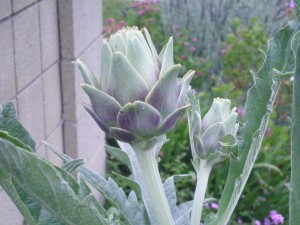In all honesty, artichokes are probably a spring crop, but here in So Cal, they are ready for me to eat 🙂
A single artichoke is actually an unopened flower bud from a thistle-like plant, Cynara scolymus. It’s a member of the daisy family.
They were avidly cultivated in the fifteenth century in Florence and was reputedly taken to France by Catherine de Médicis, wife of Henry II. The French, Italians, and the Spanish continue to be the leading growers and consumers of artichokes. It was European immigrants who brought artichokes to the United States in the nineteenth century to Louisiana and then later to the mid-coastal regions of California, where the cool, foggy climate is ideal for growing.
Artichokes have an intricate structure, which keep people away from them. Here is what to look for in a fresh artichoke when you are shopping for them in the grocery store: compact and heavy for its size, with leaves or scales, that is fleshy, thick, firm and tightly closed. Of course there are always marinated, frozen or canned versions. To steam an artichoke, it does take 20-45 minutes to cook. You can also find frozen artichoke hearts which only need a brief cooking period before enjoying them.
Why eat them? A few years ago, a friend and I were discussing the merits of the artichoke and I thought “if more people knew their nutritional value they might be used in cooking more than they are.” So here it is: they are rich source of vitamin C and dietary fiber; great sources for folate and potassium. If you are going to eat them with a dipping sauce, the key is to choose a low fat one.
Here is a recipe from Simply Recipes that also includes information on their website on how to eat an artichoke.
How to Cook an Artichoke
• Prep time: 5 minutes
• Cook time: 35 minutes
METHOD
1. If the artichokes have little thorns on the end of the leaves, take a kitchen scissors and cut of the thorned tips of all of the leaves. This step is mostly for aesthetics as the thorns soften with cooking and pose no threat to the person eating the artichoke.
2. Slice about 3/4 inch to an inch off the tip of the artichoke.
3. Pull off any smaller leaves towards the base and on the stem.
4. Cut excess stem, leaving up to an inch on the artichoke. The stems tend to be more bitter than the rest of the artichoke, but some people like to eat them. Alternatively you can cut off the stems and peel the outside layers which is more fibrous and bitter and cook the stems along with the artichokes.
5. Rinse the artichokes in running cold water.
6. In a large pot, put a couple inches of water, a clove of garlic, a slice of lemon, and a bay leaf (this adds wonderful flavor to the artichokes). Insert a steaming basket. Add the artichokes. Cover. Bring to a boil and reduce heat to simmer. Cook for 25 to 45 minutes or until the outer leaves can easily be pulled off. Note: artichokes can also be cooked in a pressure cooker (about 15-20 minutes cooking time). Cooking time depends on how large the artichoke is, the larger, the longer it takes to cook.



